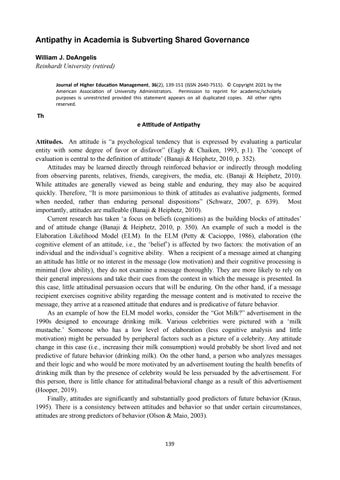Antipathy in Academia is Subverting Shared Governance William J. DeAngelis
Reinhardt University (retired) Journal of Higher Education Management, 36(2), 139-151 (ISSN 2640-7515). © Copyright 2021 by the American Association of University Administrators. Permission to reprint for academic/scholarly purposes is unrestricted provided this statement appears on all duplicated copies. All other rights reserved.
Th e Attitude of Antipathy Attitudes. An attitude is “a psychological tendency that is expressed by evaluating a particular entity with some degree of favor or disfavor” (Eagly & Chaiken, 1993, p.1). The ‘concept of evaluation is central to the definition of attitude’ (Banaji & Heiphetz, 2010, p. 352). Attitudes may be learned directly through reinforced behavior or indirectly through modeling from observing parents, relatives, friends, caregivers, the media, etc. (Banaji & Heiphetz, 2010). While attitudes are generally viewed as being stable and enduring, they may also be acquired quickly. Therefore, “It is more parsimonious to think of attitudes as evaluative judgments, formed when needed, rather than enduring personal dispositions” (Schwarz, 2007, p. 639). Most importantly, attitudes are malleable (Banaji & Heiphetz, 2010). Current research has taken ‘a focus on beliefs (cognitions) as the building blocks of attitudes’ and of attitude change (Banaji & Heiphetz, 2010, p. 350). An example of such a model is the Elaboration Likelihood Model (ELM). In the ELM (Petty & Cacioppo, 1986), elaboration (the cognitive element of an attitude, i.e., the ‘belief’) is affected by two factors: the motivation of an individual and the individual’s cognitive ability. When a recipient of a message aimed at changing an attitude has little or no interest in the message (low motivation) and their cognitive processing is minimal (low ability), they do not examine a message thoroughly. They are more likely to rely on their general impressions and take their cues from the context in which the message is presented. In this case, little attitudinal persuasion occurs that will be enduring. On the other hand, if a message recipient exercises cognitive ability regarding the message content and is motivated to receive the message, they arrive at a reasoned attitude that endures and is predicative of future behavior. As an example of how the ELM model works, consider the “Got Milk?” advertisement in the 1990s designed to encourage drinking milk. Various celebrities were pictured with a ‘milk mustache.’ Someone who has a low level of elaboration (less cognitive analysis and little motivation) might be persuaded by peripheral factors such as a picture of a celebrity. Any attitude change in this case (i.e., increasing their milk consumption) would probably be short lived and not predictive of future behavior (drinking milk). On the other hand, a person who analyzes messages and their logic and who would be more motivated by an advertisement touting the health benefits of drinking milk than by the presence of celebrity would be less persuaded by the advertisement. For this person, there is little chance for attitudinal/behavioral change as a result of this advertisement (Hooper, 2019). Finally, attitudes are significantly and substantially good predictors of future behavior (Kraus, 1995). There is a consistency between attitudes and behavior so that under certain circumstances, attitudes are strong predictors of behavior (Olson & Maio, 2003).
139




